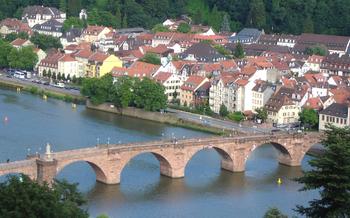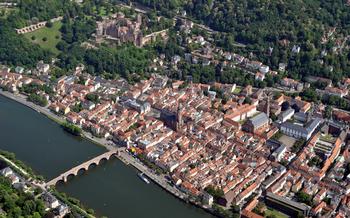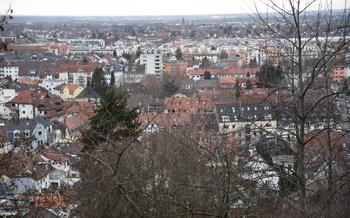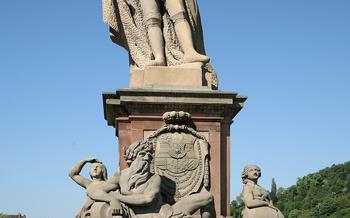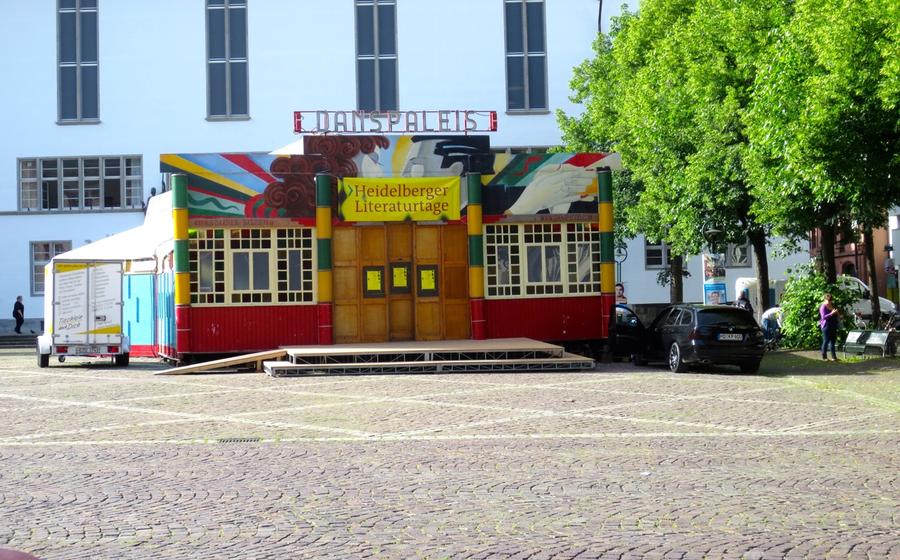
The University Square (Universitätsplatz)
- The Heart of Heidelberg:
- Old University Building
- Studentenkarzer
- New University Building
- Heiliggeistkirche:
- Kurpfälzisches Museum
- Alte Aula
- Haus zum Ritter
- Bismarckplatz
- Shopping and Dining
- Heidelberg Student Prison Museum:
- Heidelberg University Library:
- Old Town Hall
- Old Bridge (Alte Brücke):
The Heart of Heidelberg:
Universitätsplatz, the beating heart of Heidelberg's Old Town, stands as a testament to the city's rich history and academic heritage. This vibrant square, lined with architectural marvels and steeped in centuries of student life, offers a captivating glimpse into Heidelberg's past and present.
Nestled amidst narrow cobbled streets and charming cafes, Universitätsplatz has been the focal point of Heidelberg's academic and social life for centuries. Its history dates back to the 14th century when the University of Heidelberg, Germany's oldest university, was founded. The square quickly became a hub of student activity, with lecture halls, dormitories, and student taverns springing up around it.
To reach this historic square, take a leisurely stroll along Hauptstraße, Heidelberg's main shopping street, and turn left onto Universitätsplatz. Alternatively, hop on a tram and alight at the Universitätsplatz stop, just a stone's throw away.
As you step into Universitätsplatz, be prepared to be mesmerized by its architectural wonders. The square is dominated by the imposing Old University Building, a masterpiece of Renaissance architecture, and the New University Building, a stunning example of Neo-Gothic style. The Heiliggeistkirche, with its soaring spire and intricate carvings, adds a touch of sacred grandeur to the square.
Old University Building
The Old University Building (Alte Universität) is an iconic landmark in Universitätsplatz, steeped in history and architectural grandeur. It was established in 1386, making it one of the oldest universities in Germany. The building's history is intertwined with the development of Heidelberg as a renowned center of learning and scholarship.
Its construction in the late 18th century showcased a blend of Baroque and Renaissance architectural styles. The striking facade features intricate carvings, ornamental gables, and a majestic entrance that beckons visitors to step into the realm of knowledge. The building's imposing presence dominates the square, embodying the university's rich heritage and academic excellence.
Notable elements of the Old University Building include the Aula, a grand hall used for ceremonies and lectures, renowned for its ornate ceiling frescoes and elegant chandeliers. The Senate Room, where important university decisions are made, exudes an atmosphere of wisdom and authority with its paneled walls and stately furnishings.
The prison tower (Karzer), an intriguing feature of the building, once served as a place of confinement for students who misbehaved. Its small, dark cells hold stories of student pranks and disciplinary measures, adding a touch of mystery and intrigue to the building's history.
Studentenkarzer
The Studentenkarzer, also known as the Student Prison, is an intriguing and unique feature of the Universitätsplatz in Heidelberg.
New University Building
The New University Building (Neue Universität) stands as a testament to Heidelberg University's continued growth and academic excellence. In 1931, the university's expansion necessitated the construction of a new building to accommodate the increasing student population and faculty. Constructed in a neo-Baroque style, the New University Building harmoniously blends with the city's architectural heritage.
The building's grand facade is adorned with intricate carvings and sculptures, reflecting the university's rich history and contributions to academia. Inside, visitors are greeted by a spacious and elegant courtyard, surrounded by lecture halls, offices, and research facilities. The New University Building has become a hub for academic collaboration and intellectual discourse, fostering a vibrant and stimulating environment for students and researchers alike.
One of the notable features of the New University Building is the Assembly Hall (Aula), a magnificent space used for lectures, conferences, and special events. The hall's high ceilings, ornate chandeliers, and stained-glass windows create an awe-inspiring atmosphere. The Assembly Hall has witnessed many historical moments, including speeches by renowned scholars, debates on groundbreaking ideas, and the conferral of honorary degrees to distinguished individuals.
The New University Building also houses several institutes and research centers, dedicated to advancing knowledge in various fields. These include the Institute for Theoretical Physics, the Institute for American Studies, and the Heidelberg Center for Molecular Biology. The presence of these research facilities further enhances the university's reputation as a leading center of academic excellence.
In conclusion, the New University Building stands as a symbol of Heidelberg University's commitment to providing a world-class education and fostering a dynamic environment for intellectual exploration. Its architectural grandeur and academic significance make it a must-visit destination for anyone interested in the history and culture of Heidelberg.
Heiliggeistkirche:
The Heiliggeistkirche, or Holy Ghost Church, stands as a testament to Heidelberg's rich religious heritage. Built in the 14th century, this Gothic masterpiece boasts an awe-inspiring facade adorned with intricate carvings and sculptures. Its towering spire, reaching towards the heavens, dominates the skyline of Universitätsplatz, adding a touch of grandeur to the square.
Step inside the Heiliggeistkirche, and you'll be transported back in time. The vaulted ceilings, supported by slender columns, create a sense of spaciousness and tranquility. The stained-glass windows, with their vibrant colors and intricate designs, bathe the interior in a warm, ethereal light. Each window tells a story from the Bible, adding to the church's spiritual significance.
One of the highlights of the Heiliggeistkirche is the magnificent altarpiece, a masterpiece of late Gothic art. Carved from wood and painted with intricate detail, it depicts scenes from the life of Christ. The expressiveness of the figures and the vivid colors make it a true work of art.
For those interested in history, the Heiliggeistkirche holds many secrets. In the crypt below the church, you'll find the tombs of prominent figures from Heidelberg's past, including the founder of the university, Ruprecht I. Their stories, intertwined with the history of the city, add to the allure of this sacred space.
Kurpfälzisches Museum
The Kurpfälzisches Museum is a treasure trove of art and history, located just a stone's throw from the Universitätsplatz, in Heidelberg, Germany. Founded in 1879, the museum houses a diverse collection that spans centuries and artistic movements.
The museum's collection showcases the rich cultural heritage of the Palatinate region. Here, visitors can admire exquisite works by renowned artists, such as Lucas Cranach the Elder, Hans Baldung Grien, and Carl Spitzweg. The museum also boasts an impressive collection of sculptures, tapestries, and decorative arts.
Among the highlights of the Kurpfälzisches Museum is the "Madonna of Heidelberg," a 14th-century wooden sculpture that is considered one of the finest examples of Gothic art in Germany. Visitors can also marvel at the "Raising of Lazarus," a masterpiece by the Renaissance painter Hans Holbein the Younger.
The museum's collection is not limited to fine art. It also features exhibits on the history and culture of the Palatinate region. Visitors can learn about the region's rich archaeological heritage, its role in the Reformation, and its vibrant Jewish community.
Temporary exhibitions and special events are regularly held at the Kurpfälzisches Museum, offering visitors the opportunity to engage with contemporary art and cultural issues. Whether you are an art enthusiast, a history buff, or simply seeking a glimpse into the cultural heritage of Heidelberg, the Kurpfälzisches Museum is a must-visit destination.
Alte Aula
The Alte Aula (Old Assembly Hall) is a remarkable building located on the west side of the Universitätsplatz. This neo-Gothic structure was constructed between 1886 and 1888 and served as the main assembly hall of Heidelberg University until the construction of the New University in 193Designed by the renowned German architect Heinrich von Eckardt, the Alte Aula showcases a stunning blend of Gothic and Renaissance Revival styles.
Its façade is adorned with intricate carvings, gargoyles, and a central rose window, while the interior features a grand hall with a high vaulted ceiling, stained glass windows, and an impressive organ. The hall can accommodate up to 1,600 people and has hosted numerous prestigious events, lectures, and concerts over the years.
Today, the Alte Aula serves as a venue for various academic, cultural, and social events, including lectures, conferences, concerts, exhibitions, and graduation ceremonies. It is also open to the public for guided tours, allowing visitors to admire its architectural beauty and learn about its rich history.
Haus zum Ritter
The Haus zum Ritter (House of the Knight) is a historic building located on the Universitätsplatz. It was constructed in the 16th century and is renowned for its intricate Renaissance-style facade. The building's name originates from a legend associated with the knight Saint George slaying a dragon. According to local folklore, the knight rescued a princess from the clutches of the fearsome beast, and the building was erected to commemorate this heroic act.
The Haus zum Ritter's architectural design showcases a blend of Gothic and Renaissance elements. The facade is adorned with elaborate carvings, including intricate depictions of biblical scenes, mythological creatures, and historical figures. The building's entrance features a remarkable stone archway, showcasing intricate carvings and sculptures.
Currently, the Haus zum Ritter serves as a restaurant and cafe, offering a delightful culinary experience in a historic setting. Visitors can indulge in traditional German cuisine while immersing themselves in the building's captivating history and architectural grandeur.
Bismarckplatz
Bismarckplatz is another significant square located near Universitätsplatz. It was named after Otto von Bismarck, the first Chancellor of the German Empire. The square is surrounded by several notable buildings and landmarks.
The most prominent building on Bismarckplatz is the Bismarck Column, a 43-meter-high monument erected in 1869 to honor Otto von Bismarck. The column is made of red sandstone and features a statue of Bismarck at its top.
Another notable building on Bismarckplatz is the Prinz Carl Palais, a beautiful neoclassical palace built in the 18th century. The palace is currently used as the seat of the Regional Court of Heidelberg.
Bismarckplatz is also home to the Heidelberg Theater, one of the oldest theaters in Germany. The theater was built in 1853 and has hosted numerous renowned performances over the years.
The square is a popular gathering place for locals and tourists alike. It is often used for events and festivals, including the annual Christmas market. Bismarckplatz is a great place to relax and enjoy the vibrant atmosphere of Heidelberg.
Shopping and Dining
The Universitätsplatz area is a shopper's paradise, with a wide range of unique shops and boutiques catering to every taste and budget. From traditional German handicrafts and souvenirs to high-end fashion and designer labels, you're sure to find something special to take home. Be sure to explore the charming side streets and alleys, where you'll find hidden gems like cozy cafes, independent bookstores, and art galleries.
For a truly authentic Heidelberg experience, indulge in the local culinary delights. The area around Universitätsplatz is home to a diverse selection of restaurants and cafes, serving everything from traditional German fare to international cuisine. Don't miss the chance to try regional specialties like Maultaschen (Swabian ravioli), Flädle (pancakes), and Kartoffelsalat (potato salad). For a sweet treat, be sure to sample the local specialty, Heidelberger Studentenkuss (student's kiss), a chocolate-covered marzipan ball.
Heidelberg Student Prison Museum:
A Window into Student Life in Old Heidelberg
Nestled in the heart of Heidelberg's Old Town, the Heidelberg Student Prison Museum offers a unique glimpse into the lives of students in the city's past. Established in 1823, the prison served as a disciplinary measure for unruly students at the University of Heidelberg. It remained in operation until 1914, housing students who had committed various offenses, from academic misconduct to rowdy behavior.
The museum's exhibits and displays provide a fascinating insight into the daily lives of these incarcerated students. Visitors can see the cramped cells where they were confined, the graffiti they etched on the walls, and the punishments they faced. The museum also showcases artifacts related to student life in Heidelberg, such as student uniforms, textbooks, and beer steins.
The Heidelberg Student Prison Museum is a must-visit for anyone interested in the history of education and student life. It offers a unique perspective on the challenges and experiences faced by students in the past, and sheds light on the evolution of university culture in Germany.
Heidelberg University Library:
The Heidelberg University Library is a gem nestled in the heart of the city, steeped in history and knowledge. Founded in 1386, it is one of the oldest and most renowned university libraries in the world. The library boasts an impressive collection of over 3 million books, manuscripts, and rare artifacts, making it a treasure trove for scholars and bibliophiles alike.
The library's architectural grandeur matches its rich collection. The main building, constructed in the late 18th century, is a testament to Baroque and Neoclassical influences, featuring an elegant façade adorned with intricate carvings and sculptures. Inside, visitors are greeted by a breathtaking sight: a grand reading room with soaring ceilings, lined with rows of wooden shelves filled with countless volumes.
Among the library's highlights is the Codex Manesse, a medieval manuscript renowned for its exquisite illustrations and intricate calligraphy. This masterpiece, dating back to the 14th century, showcases the artistic prowess of the era and offers a glimpse into the literary treasures of the past.
The Heidelberg University Library also houses a remarkable collection of ancient manuscripts, including the Codex Palatinus germanicus 848, a 9th-century manuscript containing one of the earliest known versions of the Nibelungenlied, a legendary epic poem that has captivated generations.
Special events and exhibitions are frequently held at the library, providing visitors with an opportunity to delve deeper into its vast collection and explore the fascinating world of books and scholarship.
Old Town Hall
The Old Town Hall stands as a remarkable gem within the vibrant Universitätsplatz, serving as a testament to Heidelberg's rich history and political significance. Constructed in the 18th century, this magnificent edifice boasts an intricate Baroque architectural style, characterized by ornate decorations, elegant curves, and a captivating interplay of light and shadow. Its graceful facade, adorned with sculptures and intricate carvings, reflects the artistic prowess and cultural heritage of the city.
As the seat of Heidelberg's municipal government for centuries, the Old Town Hall holds a pivotal position in the city's governance. Its grand chambers have witnessed countless debates, decisions, and ceremonies that have shaped the course of Heidelberg's development. The building's rich history is palpable within its walls, evoking a sense of awe and reverence.
Currently, the Old Town Hall serves as a cultural center, hosting a variety of events, exhibitions, and gatherings that celebrate the city's heritage and foster community engagement. Its versatile spaces accommodate art shows, historical displays, concerts, and lectures, providing a platform for local artists, scholars, and enthusiasts to share their knowledge and creativity.
Visiting the Old Town Hall is a must for anyone seeking to delve into the heart of Heidelberg's political and cultural legacy. Its architectural grandeur, historical significance, and ongoing role in the city's social fabric make it an essential stop on any exploration of Universitätsplatz.
Old Bridge (Alte Brücke):
Heidelberg's Old Bridge, known as the Alte Brücke, is an iconic landmark that spans the Neckar River, connecting the Old Town with the Neuenheim district. This magnificent bridge holds a significant place in Heidelberg's history and culture.
Constructed in the 18th century, the Alte Brücke replaced an earlier wooden bridge that had stood in its place for centuries. The bridge features nine graceful arches, each adorned with sculptures of saints and mythological figures. These intricate carvings add a touch of elegance and artistry to the bridge's overall design.
Strolling across the Alte Brücke offers breathtaking views of the Neckar River, the Old Town, and the surrounding hills. The bridge serves as a popular spot for locals and tourists alike to relax, take in the scenery, and capture stunning photographs.
One of the most captivating legends associated with the Alte Brücke is the tale of the Monkey Bridge. According to the story, a mischievous monkey once resided on the bridge, entertaining passersby with its antics. The monkey's antics and friendly nature made it a beloved figure among the locals.
To this day, the Old Bridge remains a beloved symbol of Heidelberg. Its historical significance, architectural beauty, and the enchanting legend of the Monkey Bridge make it a must-visit attraction for anyone exploring this vibrant city. Take a leisurely stroll across the bridge, admire the intricate carvings, and soak in the breathtaking views of Heidelberg's Old Town.
